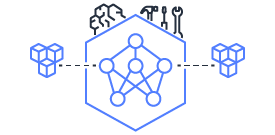This document is relevant for: Trn1, Trn2, Trn3
Registering an optimizer and LR scheduler#
A new optimizer or LR scheduler can be registered with the framework and enabled from the config.
Setting up the optimizer#
One can write their own optimizer class. One such example is the AdamW_FP32OptimParams.
The inputs to the optimizer can be exposed in the config YAML file. To do this, we need to create a Params class
as shown below:
from dataclasses import dataclass
from typing import Any, Dict, Optional, Tuple
from omegaconf import MISSING
@dataclass
class OptimizerParams:
"""
All the params listed below can be configured from the YAML file
"""
lr: Optional[float] = MISSING
betas: Tuple[float, float] = (0.9, 0.999)
eps: float = 1e-08
weight_decay: float = 0
amsgrad: bool = False
Once we create the optimizer and the optimizer params class, we can now register the optimizer with the framework using the following code:
from nemo.core.optim import register_optimizer
# `adamw_fp32OptState` would be the name in the optim config of the YAML file.
register_optimizer("adamw_fp32OptState", AdamW_FP32OptimParams, OptimizerParams)
This registration can be done inside the training.py file which resides in examples folder.
Once the registration is done, we can now expose the OptimizerParams under optim config of the
YAML file.
Setting up the LR scheduler#
One can write their own LR scheduler and register with the framework. One such example of LR scheduler is shown below:
from functools import partial
from torch.optim.lr_scheduler import LambdaLR
from transformers.optimization import _get_linear_schedule_with_warmup_lr_lambda
class LinearAnnealingWithWarmUp(LambdaLR):
def __init__(self, optimizer, warmup_steps, max_steps, last_epoch=-1):
lr_lambda = partial(
_get_linear_schedule_with_warmup_lr_lambda,
num_warmup_steps=warmup_steps,
num_training_steps=max_steps,
)
super().__init__(optimizer, lr_lambda, last_epoch)
Once we build this LR scheduler, we can expose the arguments to the config YAML file. Before that,
we need to write up a LRSchedulerParams class. Here is an example for the same:
from nemo.core.config.schedulers import SchedulerParams
class LinearAnnealingWithWarmupParams(SchedulerParams):
warmup_steps: int = 0
max_steps: int = 0
Once the LR scheduler and the SchedulerParams class are set, we can now register the scheduler
with the framework as below:
from nemo.core.optim.lr_scheduler import register_scheduler
# Here, `LinearAnnealingWithWarmUp` is the name of the scheduler we would use in the config YAML file
register_scheduler("LinearAnnealingWithWarmUp", LinearAnnealingWithWarmUp, LinearAnnealingWithWarmupParams)
This registration can be done inside the training.py file which resides under examples folder.
Once the registration is done, we can now expose the LinearAnnealingWithWarmupParams under sched config
of the YAML file.
This document is relevant for: Trn1, Trn2, Trn3
